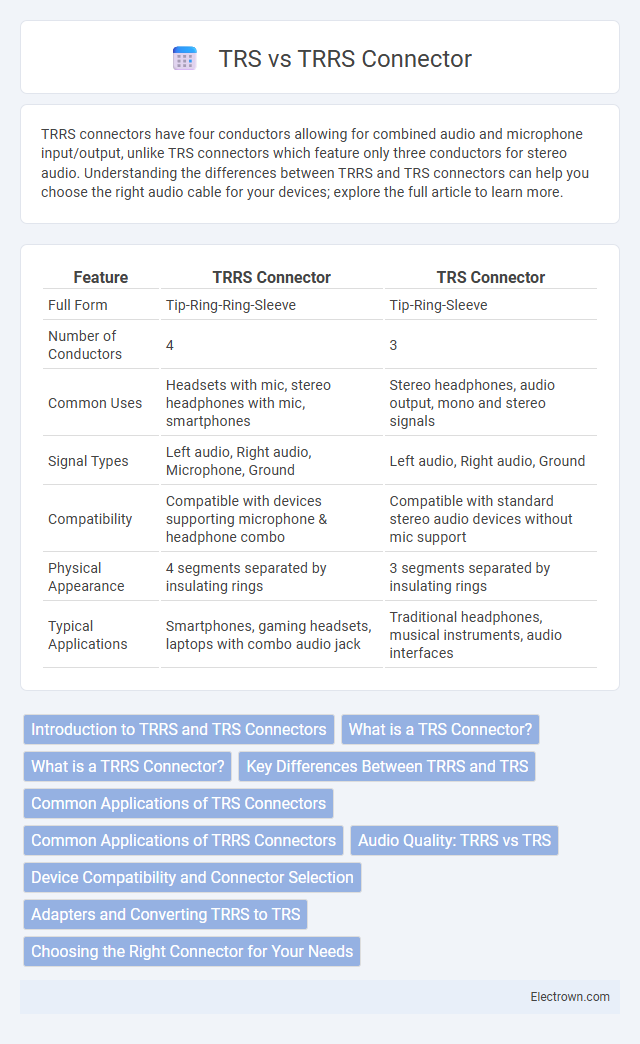TRRS connectors have four conductors allowing for combined audio and microphone input/output, unlike TRS connectors which feature only three conductors for stereo audio. Understanding the differences between TRRS and TRS connectors can help you choose the right audio cable for your devices; explore the full article to learn more.
Table of Comparison
| Feature | TRRS Connector | TRS Connector |
|---|---|---|
| Full Form | Tip-Ring-Ring-Sleeve | Tip-Ring-Sleeve |
| Number of Conductors | 4 | 3 |
| Common Uses | Headsets with mic, stereo headphones with mic, smartphones | Stereo headphones, audio output, mono and stereo signals |
| Signal Types | Left audio, Right audio, Microphone, Ground | Left audio, Right audio, Ground |
| Compatibility | Compatible with devices supporting microphone & headphone combo | Compatible with standard stereo audio devices without mic support |
| Physical Appearance | 4 segments separated by insulating rings | 3 segments separated by insulating rings |
| Typical Applications | Smartphones, gaming headsets, laptops with combo audio jack | Traditional headphones, musical instruments, audio interfaces |
Introduction to TRRS and TRS Connectors
TRRS and TRS connectors are widely used audio jacks designed for different functionalities; TRS (Tip-Ring-Sleeve) connectors typically carry stereo audio signals, while TRRS (Tip-Ring-Ring-Sleeve) connectors support stereo audio plus a microphone or video signal. Your choice between TRRS and TRS connectors depends on the device compatibility and the need for additional input capabilities such as microphone support. Understanding the pin configuration and signal transmission of each connector ensures optimal audio performance and connectivity in headphones, headsets, and other audio devices.
What is a TRS Connector?
A TRS connector, standing for Tip-Ring-Sleeve, is a type of audio jack commonly used for stereo headphones and balanced audio signals. It features three contact points: the tip carries the left audio channel, the ring carries the right audio channel, and the sleeve serves as the ground. Understanding the TRS connector's function helps you ensure compatibility with audio devices, avoiding issues like mono sound or lack of microphone input.
What is a TRRS Connector?
A TRRS connector, short for Tip-Ring-Ring-Sleeve, is an audio jack that supports stereo sound and a microphone simultaneously, making it ideal for smartphones, gaming headsets, and laptops. Unlike the TRS connector, which has three contact points for stereo audio, the TRRS includes an extra ring to carry microphone signals or additional audio channels. Your choice of a TRRS connector ensures compatibility with devices requiring both audio output and input through a single plug.
Key Differences Between TRRS and TRS
TRRS connectors have four contact points, providing stereo audio plus a microphone or video signal, while TRS connectors have three contact points, typically carrying only stereo audio. Your choice depends on device compatibility; TRRS is common in smartphones and headsets with microphones, whereas TRS is standard for headphones and audio equipment without mic support. The extra ring in TRRS enables multifunctionality, making it ideal for devices requiring both audio input and output.
Common Applications of TRS Connectors
TRS connectors are widely used in audio applications such as connecting headphones, musical instruments, and microphones to audio equipment. They are commonly found in professional audio gear, DJ mixers, and portable audio devices due to their ability to carry balanced audio signals or stereo unbalanced signals. Their widespread use in consumer and professional audio setups makes them a versatile choice for high-quality sound transmission.
Common Applications of TRRS Connectors
TRRS connectors are commonly used in smartphones, laptops, and gaming headsets to support combined audio input and output functions, such as headphones with integrated microphones. They enable seamless connectivity for devices that require stereo sound and microphone audio through a single jack, enhancing user convenience and device functionality. This makes TRRS connectors essential in communication devices and multimedia applications where both listening and speaking capabilities are needed.
Audio Quality: TRRS vs TRS
TRRS connectors feature an additional ring allowing for stereo audio combined with a microphone channel, which can slightly impact audio quality due to potential signal interference. TRS connectors, designed for stereo audio without a microphone, often provide a cleaner and more stable sound output, making them ideal for pure audio applications. Your choice between TRRS and TRS connectors should consider the balance between audio quality and the need for microphone integration.
Device Compatibility and Connector Selection
TRRS connectors support both audio and microphone signals, making them ideal for smartphones, laptops, and gaming headsets requiring combined input/output functionality. TRS connectors typically handle stereo audio only, which suits devices like traditional headphones, speakers, and audio equipment without mic support. When selecting a connector, consider your device's compatibility needs--choose TRRS for integrated communication features and TRS for straightforward stereo audio.
Adapters and Converting TRRS to TRS
Converting TRRS to TRS requires specific adapters designed to split the combined audio and microphone signals of TRRS into separate stereo audio and mic channels typical of TRS connectors. TRRS to TRS adapters ensure compatibility between headsets with integrated microphones and devices with separate headphone and mic jacks. Selecting high-quality TRRS to TRS adapters prevents signal loss and maintains audio clarity for seamless device connectivity.
Choosing the Right Connector for Your Needs
Choosing the right connector between TRRS and TRS depends on your device compatibility and audio requirements. TRS connectors support stereo audio with separate left and right channels, ideal for basic headphones or mono microphones, while TRRS connectors add a fourth ring to enable additional functionality like microphone input and remote control on headsets. Your decision should consider whether you need integrated audio and microphone capabilities, commonly found in smartphones and gaming headsets, or simple stereo audio output.
TRRS vs TRS connector Infographic

 electrown.com
electrown.com